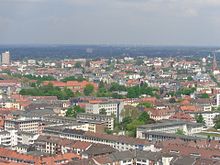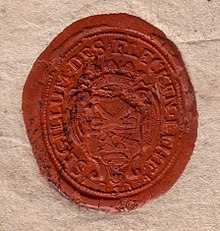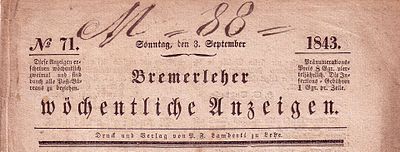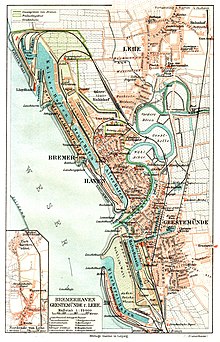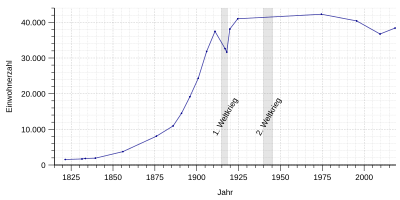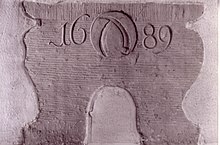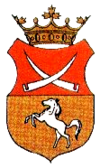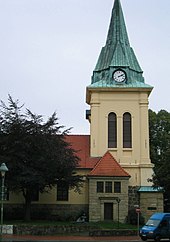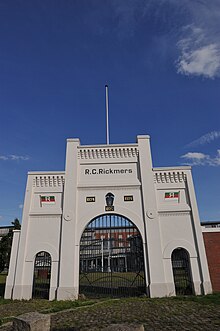Lehe (Bremerhaven)
|
Lehe
Leh ( Low German ) City of Bremerhaven
|
|
|---|---|
| Coordinates: 53 ° 34 ′ 23 " N , 8 ° 35 ′ 38" E | |
| Height : | 2 m above sea level NHN |
| Area : | 16.37 km² |
| Residents : | 38,643 (Dec. 31, 2018) |
| Population density : | 2,361 inhabitants / km² |
| Incorporation : | 1924 |
| Incorporated into: | City of Wesermünde |
| Postal code : | 27568, 27576, 27578, 27580 |
| Area code : | 0471 |
|
Location of Lehe in Bremerhaven
|
|
Lehe ( Low German Leh ) is a district of the northern district of the municipality of Bremerhaven in the Free Hanseatic City of Bremen .
geography
location
Lehe is located near the mouth of the Geeste into the Weser , not far from its mouth into the North Sea . The old town center lies on the foothills of the Hohen Lieth , which was formed during the Ice Age , the Geestrücken between Cuxhaven and Lehe, which probably gave the place its name. The centrally located district borders the districts Weddewarden and Leherheide in the north . In the southwest is the Mitte district (the old Bremerhaven), and behind it in the south is the Geestemünde district .
structure
| Districts | km² | Residents |
|---|---|---|
| Bushmen | 3.24 | 722 |
| Eckernfeld | 1.94 | 5,332 |
| Goethestrasse | 0.55 | 8,150 |
| Klushof | 2.23 | 10,469 |
| Schierholz | 2.66 | 6,193 |
| Speckenbüttel | 4.50 | 3.137 |
| Twischkamp | 1.25 | 4,640 |
(As of December 31, 2018; source :)
history
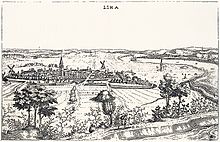
The name
Lehe was often referred to as Lee or Le . The name can also come from the Old Saxon syllables lewa or lio . The place name, which occurs more frequently in northern Germany, can also be found, for example, in Lehe (Dithmarschen) , Lehe (Emsland) in the joint municipality of Dörpen or in the Lehe district in Bremen - Horn-Lehe .
The district names
Bushmen
Buschkämpen comes from the North German term Kamp and probably comes from the Latin campus for area, field, corridor or level; here for an area delimited by bushes.
Eckernfeld
Eckernfeld was also spelled Ekkernfelde , Eckerfelde or Eggerfelde earlier . The prefix Ekk comes from the Low German egg and stood for corner or edge. The Ekkernfelde district is on the corner, i.e. on the edge, of the Reidewischen ( Reithwiesen ).
Goethestrasse
The district of Goethestrasse was named after Johann Wolfgang von Goethe .
Klushof
The Klushof or the Klause (outdated for a restaurant) at the Holy Cross Chapel from 1477 of the Leher Dionysius Church gave the district Klushof am Leher Klus its name.
Schierholz
The district of Schierholz takes its name from the prefix Schier , which used to stand for Scheiden (to separate). The field name determines the hallway that bordered on the Spadener Holz (forest).
Speckenbüttel
The name Speckenbüttel is made up of bacon for dam paths made of bush and sod and from Büttel , from the Lower Saxony bodil for country estate.
The farmsteads in the small town of Ganderse , which could be reached via stick dams , were abandoned around 1450 to 1500.
The Schützenhof in the park was built in 1854. Since 1835, the Leh rifle festivals have taken place in Speckenbütteler Holz . The shooting club planted bushes and trees, laid paths and set up benches.
The Speckenbüttel powder magazine , Siebenbergensweg 65, dates from 1874/75. In 1883 a Luther memorial was erected, which stood there for around 80 years.
The riding arena, which was laid out in 1888, was converted into a cycling track after 1900, which existed until 1919.
In 1890 the design of the Speckenbütteler wood began to become Speckenbütteler Park , in which an open-air museum for the rural culture of the region has been built since 1910.
The horse-drawn tram from Lehe was extended to Speckenbüttel in 1896 and electrified in 1908. She drove through Parkstrasse until 1982 .
In the 20th century, the upper middle class settled around the park. 2,472 people lived there in 1950, 3503 in 1974 and 3271 in 1999.
In 1923 the General Turn- und Sport-Bund (ATSB) opened its sports facilities on the site of the former cycling track. The sports facility of the Leher Turnerschaft (LTS) was completed in 1951. In 1959 the Speckenbüttel outdoor pool was built.
The Speckenbüttel industrial park in the north-west has been developing since the 1980s. The main marshalling yard Speckenbüttel1 is also under construction from 1982. A new, large substation for the ports went into operation.
In 1984/86 the Lehe farmhouse association built a post mill in the park after previous mills had burned down in 1942 and 1983. The willow castle in the park was built in 2003 as a project by the Horticultural Office based on a design by the architect Marcel Kalberers. The high ropes course has been part of the "Health Park" since 2003.
An interactive wind turbine in Speckenbüttel has been operated by the Bremerhaven University of Applied Sciences since 2010 .
Twischkamp
Twischkamp is a combat between ( twischen ) fields.
Early history
In May 2019, archaeologists discovered the remains of a residential stable from the Iron Age during excavations at Bütteler Straße 6 at a depth of 1.2 meters . In addition to other confirmed findings , such as storage pits and ceramic shards , a well from the last century BC First traces of settlement. For decades, the swimming pool of the sauna at the lime kiln was located above the site .
middle Ages
Lehes oldest settlement originated on the Geestrücken on today's Langener Landstrasse. Settlement can be assumed as early as the Carolingian era . Securing overflow dikes and then sea dikes are accepted from 1100 and 1200 respectively. Frisian settlers received inheritable land from the Counts of Oldenburg and the lords of Bederkesa Castle . The colonists received the usual Holler rights from the Archbishopric of Bremen .
Lehe is mentioned
Lehe was first mentioned in 1273/1278 as Dorpe Lee in a fiefdom register of the Counts of Oldenburg . The parish of Lehe had a field mark of around 3,000 hectares. At the beginning of the 13th century (around 1200, other sources around 1100) the Dionysius Church was built in Lehe.
A parish school had existed since the Middle Ages, which stood on the south side of the churchyard of the then Jakobikirche, later Dionysius Church. Lessons were later given here in the German school on the ground floor by a vicar, then by a schoolmaster from Bremen. The pastor and later a rector and a schoolmaster taught in the Latin school on the upper floor.
Stains Lehe has meaning
The spots Lehe won a more than local significance as a ship's berth at the Geeste, Headquarters and market town with less urban rights in a region that otherwise had no cities. The market took place near the Geeste ferry (market cross from 1610).
Lehe is mentioned in 1310 when a dispute between the provost Erpo Mule and the inhabitants of the country Wursten was settled by the knights of Bederkesa and Ritzebüttel in the churchyard of Dionysius Church. Since at least 1525, Lehe had its own administrative organization. Politically, the area at the mouth of the Geeste has long been in conflict between the interests of the Archdiocese of Bremen and the Bremen Council . In 1326 the city of Bremen allied itself with the state of Wursten against Lehe. In 1399, Lehe placed itself under the protection of the Archbishop of Bremen in order to fend off attempts at power by the city of Bremen. In the conflict between Archbishop and Land Wursten in 1408 the Stinteburg was destroyed by the Wursters.
Court in Lehe
The Leher court was first mentioned in documents from 1400. The Oldenburg counts pledged sausages and lehe to the city of Bremen in 1408. And so Lehe concluded several times - first in 1421 and then in 1435 and 1447 - protection treaties with the Bremen council in order to prevent the archbishop from influencing power. In the 15th century, the Bremen rural community had twelve jurors. The Vogt was determined by Bremen. The parish of Lehe had two farmers, each with two quarters. The parish court was called the district court and was chaired by a councilor. The "open" court took place in the churchyard until the council of Bremen bought a house in the Büttel in Lehe in 1633 , which served as such until 1829.
Leher Klus
In 1477 a clergyman from Bremen confirmed in a document that the Holy Cross Chapel (located in the area of Stresemannstrasse No. 197 to 203) was built and equipped in the parish of Lehe . The single-nave chapel is recognizable in a Dillich engraving by Leha in 1600 with the name Clause on a postcard motif from 1901. The chapel was also known as Leher Klus and the street Am Klushof commemorates it. It was probably destroyed by a storm in 1625. It was near a harbor that is believed to be in the area of Philippsfield, the townhouses and Melchior-Schwoon-Strasse. After the chapel was demolished, a cemetery was built here and was buried here until 1827.
Fight with sausages and the ore pen
From 1484 and 1499 Lehe successfully participated in the struggle of the state of Wursten to repel Duke Johann IV of Saxony-Lauenburg .
Around 1500 (other sources 1450) the place Ganderse near Speckenbüttel was given up and the inhabitants incorporated into Lehe.
In 1511, Oldenburg can redeem pledged income rights and keep them until 1852; Lehe remains with the Bremer Erzstift until 1648.
In 1517, 1518 and 1525 Lehe experienced three times how the troops of Archbishop Christoph von Bremen defeated the Land of Wursten and burned the uninvolved Lehe down in each case. In 1526, after the Archbishop had defeated Wursten, the Archbishopric of Bremen took control of Lehe.
In 1532 the Leher chased the Wurster away who illegally wanted to build a dike in Leher area.
Early modern age
Reformation and after
In 1534, Lehe followed the example of Bremen (from 1524/1531) following the Lutheran Reformation , whose territories were united in the Schmalkaldic League .
In 1539 an even older school was mentioned for the first time, which was located in the parish of St. Jakobi / Dionysius. Towards the end of the 16th century there was a separate Lutheran and Reformed school.
In 1547, during the Schmalkaldic War , Leher Landsknechte defended the city of Bremen against the imperial troops . Looting in Lehe by the imperial could be avoided through the mediation of the County of Oldenburg and money payments.
From 1568 to 1587 Lehe achieved that it did not have to pay a “ Turkish tax ” to Bremen. In 1588 Lehe was allowed by the Bremen council to hold two annual markets as cattle and goods markets - in April / May and in September.
During the Thirty Years' War Tilly moved into Lehe in 1627 and the town was able to avoid permanent billeting through cash benefits. The Leher Schanze was built in 1639 in the last loop of the Geeste before the mouth of the Weser at the instigation of the Protestant administrator and Archbishop Friedrich III. It had earth bastions . It was demolished around 1648 at Bremen's instigation, renewed in 1653 by the Swedes under Königsmarck and given up in 1672 in favor of Carlsburg .
Sweden time
In 1648, due to the Peace of Westphalia, the Archdiocese of Bremen - including Lehe - came under Swedish sovereignty. Since Bremen did not want to recognize this, the Swedes also occupied Lehe and the Leher Schanze in 1653. In 1654, the First Stade Settlement finally sealed that Lehe became part of the Swedish Duchy of Bremen in the Holy Roman Empire .
The Carlsburg
The Swedes founded in 1672 the after King Carl XI. The fortress town of Carlsburg named by Sweden at the confluence of the Geeste with the Weser (today the Bremerhaven University of Applied Sciences is located here ) in the Leh area. The Leher Schanze was given up. Johann Besser became provisional mayor of the settlement. In 1675–1676, the unfinished land and sea complex was besieged by troops from the Duchy of Braunschweig and Lüneburg , the Electorate of Brandenburg , the Diocese of Munster , the United Netherlands and the Kingdom of Denmark and finally occupied by the Danes. Carlsburg became part of Braunschweig-Lüneburg. The fortress was demolished in 1683 and the last cannons were transported to Stade around 1700 . Lehe remained with the Swedes (from 1680). The Alte Privilegierte Apotheke Lehe was founded around 1680 .
After the Northern Wars
In 1711 the Danes win the Northern Wars and also occupy Lehe. In 1719 Denmark sold the Duchy of Bremen to the Electorate of Braunschweig-Lüneburg , which later became the Kingdom of Hanover .
In 1713 a foundation was established that built a Latin school.
Lehe also temporarily had its own small port on the Geeste. But its location was ill-suited to play an important role. Hanover refused to build a port in 1798 and again in 1800.
In 1753 (other sources 1751) a wooden Geestebrücke was built between Lehe and Geestendorf, which was later named Franzosenbrücke and existed until the 1950s.
In the Seven Years' War Hanover fought on the Prussian side and Lehe had to endure the stresses of hostile French occupations from 1757 to 1763 and then the billeting of allied British troops.
In 1776, the forced soldiers of the Landgrave of Hesse-Kassel were embarked as mercenaries in English service for use in the American War of Independence from the bank of the Geeste in Lehe.
1800 to 1900
In 1801 the church and school house burned down. In 1803 the newly built ev.-luth. Dionysius Church , popularly known as the Old Church , has been consecrated again.
schools
From 1801, all schools were taught in rented rooms.
From 1859 onwards, the Lutheran school separated children according to gender. The new Lutheran Old Post School , with six classrooms, was built in 1861 behind the old school that had burned down. New buildings were added: the Marktschule in 1871 , the Neuenlandschule in 1881 , the Deichschule in 1885, the Leherheide School in 1894 , the Gardener's School in 1896 and the New Market School in 1901 .
In 1856 a classroom building was maintained on the market for the reformed school ; in 1871 it had three classes there. In 1886 a new building was built on Reuterstraße.
After the church fire in 1856, the new school building on the market was also built for the Latin school, which was then called the Rector's School .
The Catholic school was built in 1879 at Hafenstrasse 99 with additions from 1903 and 1911.
From 1865 to 1904 there was a private secondary school for girls in rented rooms on Hafenstrasse.
The French period
To enforce the continental blockade against the British Isles, Napoleon waged a war against Great Britain and against the Electorate of Hanover, which was united in the common ruling house, and in 1803 occupied Electorate Hanover . In 1805 British troops entered Lehe. After the battle of Jena and Auerstedt and the defeat of Prussia in October 1806 , the French occupied Lehe again. In 1808, 144 buildings burned down in a city fire. The French blocked the Weser for sea trade to Great Britain. In 1809 the British briefly occupied Karlsburg and Lehe.
In 1810 the Electorate of Hanover - and thus Lehe - became part of the new Kingdom of Westphalia controlled by the French . From 1811 Lehe belonged to the French Empire as part of the Département des Bouches du Weser . The progressive French laws, including the abolition of serfdom and local self-government, were introduced. Lehe became the administrative seat of the arrondissement Bremerlehe . In March 1813 an uprising began in Lehe, Blexen and Land Wursten; the French gave up the occupation of Karlstadt. The French appointed Maire Dassel had fled to Bremen and a teacher judge assumed the office of mayor. British soldiers supported Lehe. The French under General Saint-Cyr with 700 soldiers as well as artillery and cavalry beat down the rebels from Lehe, Debstedt , Dorum and the British bloody at the Geestebrücke on March 25 , murdered the prisoners and then Leher citizens. The bridge has since been called the Franzosenbrücke . In November 1813, the Russian Colonel Rüdiger and his troops drove out the French and the French era ended. The Franzosenstein from 1913 commemorated the "Battle of the Franzosenbrücke".
Lehe arises again near Hanover and Bremerhaven
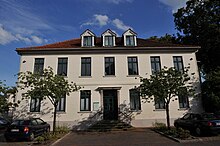
In 1817 Hanover again rejected plans to build a harbor, only a few Duckdalben were rammed into the Geeste area as jetties. In 1824, Oldenburg tried to achieve that only Brake could be used as a transshipment point on the Lower Weser. The negotiations between Bremen and Hanover from 1825 onwards led to the State Treaty on the sale of the site from what is now the Mitte district to Bremen in 1827 and the start of port construction in 1828.
With the founding of Bremerhaven, Lehes' rise began as a suburb of the new but cramped city. Many workers lived in the cheaper Lehe. Cemetery I on Friedhofsstraße was inaugurated in 1827. He replaced the church cemeteries at the Dionysius Church and at the Klushof. The road to Bremerhaven (today Hafenstrasse ) was expanded in 1829 and a new courthouse was built.
In 1830, Long Street No. 123, the Landratshaus Lehe was built, a residential building and seat for the first Leh bailiff, Richter Telting. On July 3, 1831 from the Lehe Court and the Office Stotel-Vieland (with Geestendorf ) the Office Lehe formed. The main place of the office was Lehe, which in 1834 rejected the request of the Landdrostei in Stade to receive city rights . From 1839 to around 1846 (in Leher Haide ) the common land ( common land ) of 1687 acres (1 acre = 2,500 m²) was dissolved as communal property and divided among the Leher citizens who were entitled to vote.
Lehe was inland customs and Alt-Bremerhaven was a customs exclusion area , i.e. spared from customs. Many teachers bought at reduced prices in Alt-Bremerhaven, a disadvantage for retailers in Lehe. It was not until 1888 that the urban area of Alt-Bremerhaven without the free port was connected to the customs inland of the empire by a Reich law . The four meter high wooden fence between Bremerhaven and Lehe disappeared. Otherwise, however, Lehe benefited from the supply of old Bremerhaven.
Newspaper industry
In 1841 the first newspaper appeared, the Weekly Anzeiger für Lehe, Umgebung und Land Wursten . In 1842 the weekly newspaper der Bremerleher came out in Lehe , preferably with notices for Alt-Bremerhaven and from 1861 to 1869 the Volksblatt appeared on the North Sea ; Paul Friedrich Lamberti published both newspapers . The provincial newspaper was from 1853 to 1926 at the same time the indicator for the Royal High Court District Lehe. Publisher Leopold von Vangerow and editor Otto Remmler took over this newspaper in 1857. The Leher Nachrichten was published by Schulze & Bissing Verlag in Lehe from 1882 onwards. The Leher Tageblatt was from 1897 to 1905, only a head sheet of the Nordsee-Zeitung , which was founded in 1866 in Geestemünde.
After 1848
During the revolution of 1848/49 riots also took place in Lehe. The conservative leadership, however, only aimed at improvements for the “noble spots” and tried to prevent the “influx of foreign masses”. The offered town charter was rejected again.
Alt-Bremerhaven was part of the church until the end of the 1850s. In 1850 the Leher Altmarkt and Friedhof II were laid out, which also accommodated Alt-Bremerhaven. Due to the increased construction activity, the lime kilns were built on Bütteler Strasse / Batteriestrasse in 1850 as a lime kiln , which ceased operations in 1870.
1851 was an even existing building for the new at Lange Straße 121 Office - and the Superior Court in Lehe and as Hannoversches administration building . Lehe again refuses to become a city. In 1851 the stagecoach service started from the Jägerhof restaurant . In 1852 the third bridge came over the Geeste in the area of Streesemannstrasse / Schwoonstrasse, which could be demolished again in 1894 after the Geeste had been straightened. In 1853 Schwonn's water tower was built in the city park and enlarged in 1902. The water supply in Bremerhaven came from Lehe. The old market was enlarged in 1854. A small hospital was built in 1853 on the Süderfeld. The road to Dorum and Ritzebüttel was expanded in 1855. The Sparkasse des Fleckens was founded in 1859. In 1860 the workers' education association was established. In 1861, the post school was inaugurated next to the old school on Poststrasse. From 1863 the main streets were illuminated with oil lamps , since 1865 with kerosene lamps and from 1894 with gas lamps. Helene Meyer founded a higher private daughter school in 1865 in the house of the district administrator at Hafenstrasse 6. From this, the state higher school for daughters developed in 1904 , the Kaiserin-Auguste-Viktoria-Schule from 1906 , from 1920 the municipal lyceum in Lehe and from 1924 the state Theodor- Storm school was called Wesermünde .
Lehe in the Prussian province of Hanover
In 1866 the Kingdom of Hanover lost its independence after its defeat in the German War between the German Confederation and the Kingdom of Prussia and its allies and became the Prussian Province of Hanover in 1867 . In the Landdrostei Stade there were eight districts, including the district Lehe from the old offices of Lehe and Dorum.
Since 1866, the "poor relief" was no longer carried out by the church alone, but also by the stain. From 1868 there was a large influx of citizens from Mecklenburg and Silesia , after freedom of movement of residence and freedom of trade applied in the North German Confederation . Cemetery III was created. In 1873 the road came from Lehe to Otterndorf. The Lehe gymnastics club was founded in 1869, the Leher Turnerschaft (LTS) in 1889 and the Leher Nachrichten in 1882 by the publishers Schulze & Bissing. In 1885, the Unterweser newspaper was created as a successor. In 1881, the Lehe trade association founded a commercial training school from 1873.
On January 1, 1880, the constitutional statute for Lehe came into force as a magistrate constitution with a mayor at its head. In Lehe there were two schools with 18 Lutheran and 3 Reformed classes in 1880; a trade school was established, which was given its own building on Stormstrasse in 1890. The horse-drawn tram from 1880 was extended to Speckenbüttel in 1896 and operated electrically from 1907.
In 1885 the administration by Landdroste was abolished under the new Prussian district order . From the Landdrostei Stade , the administrative district of Stade was created with 14 new districts. Lehe became the administrative seat of the district Lehe with the part of the Lehe office and the Dorum office north of the Geeste . District Administrator Geiger came to the head of the circle. The areas south of the Geeste from the Lehe office came to the Geestemünde district . In 1886 the reformed school (today Zwinglischule) moved into its school house. The Hotel Stadt Lehe opened on the Altmarkt in 1887 and has been run by the innkeeper Hinrich Seebeck since 1906.
From 1883 the barracks (including town house VI) were built on Kaiser-Wilhelm-Straße , today Hinrich-Schmalfeldt-Straße . Hafenstrasse and Rickmersstrasse were expanded in 1887 and 1897, respectively . In 1888 the inauguration of the town hall on Leher Markt took place, which was originally built as a poor house in 1865 and which was expanded in 1907. The building administration has been based here since 1973. In 1893 the gas works was built. From 1890 the Speckenbütteler Park was created by Lehe. The Buttelberg , an old Jedutenberg on Batteriestrasse, was demolished in 1893. In 1894, the gas works at Wischacker started operations. The Bremerhaven-Lehe football club was established in 1899 and was soon called VfB .
schools
The gardening school of 1896 on Gärtnerstrasse became the Luther school . The Rector's School (first Latin school) from 1713 on the Altmarkt was closed in 1897. In 1900 the Lutheran market school received a new building with 13 classes.
fire Department
Lehe initially had a compulsory fire brigade . In 1890 a fire fighting house was built on Leher Markt , which was expanded twice by 1912. In 1893/95 the volunteer fire brigade took over fire protection. In 1903 the old fire station Lehe was established on Auestrasse. In Leherheide there was a department of the volunteer fire brigade from 1909 with a new fire station from 1939 on Mecklenburger Strasse.
train
The inland customs station on Moltkestrasse was built in 1892. In 1896, the Lehe station was built on the new Bremerhaven – Cuxhaven line and on the Bremerhaven – Bederkesa line . A new station building came in 1914.
Morgenstern Museum
In 1896 Jan Bohls put a prehistoric collection in a house at Hafenstrasse 6 and exhibited it. The Men vom Morgenstern association added to the collection. In 1902 the collection was assigned to Geestemünde and in 1906 the Morgenstern Museum was founded, which became the Bremerhaven Historical Museum .
From 1900

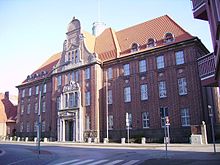
The Unterweser shipyard on the Geeste was built from 1900 to 1908. The Auesiel (Am Siel) was given up in 1900 and the Aue was led to a new Siel in the Auf den Sülten area. From 1905 to 1913 the Unterweser-Zeitung came out, which was later merged with the Nordwestdeutsche Zeitung . Lehe applied for town charter in 1906, but did not receive it until 1920.
schools
The traditional Leher schools were established after 1900, the Lessing School from 1906 as an upper secondary school in Hafenstraße , the Körnerschule I from 1908 in the then Körnerstraße and the Pestalozzi School Bremerhaven from 1910 at the Leher Tor in Bremerhaven on the border with Lehe. In Körnerschule B as a primary school, teaching has been carried out since 1912.
The private Höhere Töchterschule ( Lyceum Lehe ) in Hafenstrasse was taken over by the community in 1904 and was named Kaiserin-Auguste -schule in 1906 . In 1912 it was given a building on the corner of Mühlenstrasse and Lutherstrasse. This then became the Theodor Storm School . In 1907 Lehe took over the elementary schools from the church and from 1908 district inspectors (school councils) were responsible for them.
In 1903 the Catholic Church built a denominational school on Uhlandstrasse (today Deichschule ); An auxiliary school was also housed in the building in 1919 . The Fritz Reuter School was converted into a police station in 1936.
Churches
The neo-Gothic Protestant Pauluskirche was built from 1902 on the Großer Blinkkamp. In 1905 the 75 m high church tower followed. In 1911 the neo-Gothic Catholic Church of the Sacred Heart of Jesus was built with an adjoining school building based on designs by the architect Maximilian Jagielski in Hanover. A reformed chapel was built in 1911 on Langen Strasse.
The Lehe Hospital on Wurster Strasse (today the Health Department) was completed in 1906. In 1907 the first electric street lights were installed on Hafenstraße and the Hökerstraße electricity company went online. In 1908, the Alexis on Hafenstrasse was the first cinema to show films. The Unterweser shipbuilding company has been building fish steamers on the Geeste since 1910 . In 1912 the slaughterhouse on Schlachthofstrasse started operations. In 1917 the building of the Sparkasse and the post office on Hafenstrasse was inaugurated according to a design by the Düsseldorf architects Wilhelm Kreis and Karl August Jüngst .
Heinrich Kuhlmann (1855–1922) became an honorary citizen of Lehe in 1920 as a long-time city councilor and city councilor . The Lehe slaughterhouse and cattle yard was built on his initiative. On Friedrich Timmermann - also an honorary citizen of Lehe - was the extension of the Speckenbüttel parks in the 1920s back, which he supervised until his death (1928).
In 1920 Lehe received city rights as an independent city. As early as 1924, Lehe lost its independence and merged with Geestemünde in the new city of Wesermünde . In 1924 the fire brigades in Wesermünde were merged into the city fire brigade association .
Lehe to Wesermünde or Bremerhaven
In 1927 the teacher Hermann Schröder published the history of the city of Lehe . The Capitol cinema opened on Hafenstrasse in 1927.
In 1929 the bridge over the Geeste was built for the first section of the bypass road, Stresemannstraße . After work on the connection between Lehe and Geestemünde had stopped from 1931 to 1938, a section of the Straße der Freiheit - as it was called from 1933 to 1945 - could be carried out until 1939. It was not until the 1950s that the breakthrough came as Bundesstraße 6 from Melchior-Schwoon-Straße to Flötenkiel in the direction of Langener Landstraße .
1939 belonging to Bremen city of Bremerhaven (without further Bremen was part of the international port area Bremerhaven ) part of the province of Hannover belonging Prussian city Wesermünde .
During the Second World War , the air raids on Wesermünde on June 18, 1944 and September 18, 1944 also affected the Lehe district and lost a considerable part of its building stock. On May 7, 1945, Lehe was occupied by British and later American troops.
The city of Wesermünde became part of the Free Hanseatic City of Bremen in 1947 and shortly thereafter renamed Bremerhaven. Lehe was now a district of Bremerhaven.
On the initiative of ÖTV secretary Karl Eggers (SPD), the residential estate on the Eckernfeld was built in 1949 . A simple house cost 12,000 marks. The property developer was the weighed . A settlement community was founded in 1950 and led by Hermann Elzmann until 1975. In 1957 she received the Gauss School in the settlement . In 1959, Lehe received the district library on Breidenbachstrasse.
In 1971, Leherheide became a separate district through a new division of the districts in Bremerhaven.
In the 1980s and 1990s, extensive renovations were carried out in the Lehe district in the area of Frenssen, Körner, Kistner and Hafenstrasse as part of urban development funding. The continuation of urban renewal in Lehe took place from 2000 to 2006 as part of the ERDF -Programms URBAN II of the EU .
On January 31, 1985, two phantom fighter planes from Wittmund collided over the industrial area Speckenbüttel. One crew member and one worker died. Five others were seriously injured.
In 1998 a new volunteer fire brigade was established in Lehe, after these tasks were only performed by the Bremerhaven professional fire brigade after 1947 .
Today Lehe is considered “Germany's poorest district”.
Population development
|
|
1 in 283 houses
2 of which 1160 Lutherans, 717 Reformed , 5 Catholics, 38 Jews
3 census results, in 510 residential buildings
4 census results, in 1043 residential buildings
5 census results
politics
District conference
All citizens - including initiatives, groups and associations, schools, kindergartens, parishes and other institutions - can participate in the public district conference Lehe (STK) in the design of the district, and this through their spokesman for the Magistrate of the seaside city of Bremerhaven and the Bremerhaven city council represented. The first district conference took place on September 5, 1996.
Community leader, mayor
coat of arms
The coat of arms was valid until 1924. Then Lehe and Geestemünde became the city of Wesermünde, which got its own coat of arms.
| Blazon : "In a golden crowned and divided shield , abovetwo crossed silver scythe leaves in red , below in gold a white horse jumpingto the right ." | |
| Justification of the coat of arms: The two scythes, which were included in the coat of arms in 1589, are a pictorial representation of the place name, as Leh is the Low German name for scythe. According to a heraldic legend, the teachers had two scythes in the coat of arms because they drove away the local nobles with their scythes. This could be a reminder of the peasant uprisings in the Wesermarschen from 1204, which began in Stedingen and were suppressed in 1234 by an army of crusaders at the Battle of Altenesch. The Lower Saxony horse can be added later. |
Culture and sights
Buildings
- The Protestant Dionysius Church ( old church ) on Lange Straße from 1802–1803 on old, visible foundation walls from around 1200
- The old Privileged Pharmacy in Lehe on Poststrasse; built around 1680, alterations after 1801 and around 1900
- The Schwoon'sche water tower on Hafenstrasse according to plans by Simon Loschen from 1852/53, extension in 1902
- The Hannoversche Amtshaus on Lange Strasse from 1851
- The Rickmerswerft portal from 1857 on Paul-Halthof-Platz
- The old Lehe Town Hall on Brookstrasse from 1865; Modifications in 1887
- The Protestant neo-Gothic Pauluskirche on Hafenstrasse based on plans by Eduard Wendebourg (1902–1905)
- The catholic neo-Gothic Herz-Jesu-Kirche in Lehe on Eupener Strasse based on plans by Maximilian Jagielski (1910–1911)
- The Folklore Open-Air Museum Speckenbüttel
- The building of the district court in Lehe from 1913–16
- The Villa Seedorf , Hafenstraße 14, dates from 1877 and was the Bremerhaven registry office from 1982 to 2018, today an outpatient tumor center
- The Jewish cemetery
- The Alt-Leher School , Lange Straße 88, is a listed building
- The Speckenbüttel park gate from 1896 in the style of historicism , planner: Heinrich Lagershausen, client: Bernhard von Glahn (1825–1899)
- The lime kiln
- The Rotersand customs office was built around 1935
- The Villa Giese , Lange Straße 72, is a listed building, built in 1895 by architect Carl Pogge
- The marine swimming pool on the Geeste (Leher Schafsdeich), built in 1887
Cultural history trails
Public facilities
schools
Special schools
- Gauss School III
Elementary schools
- American school
- Astrid Lindgren School
- Gauss School I
- Luther School
- Market school
High schools
- Gauss School II
- School at Ernst-Reuter-Platz, ex Lessing School (Bremerhaven)
- School at the Leher market
Vocational school
- Workshop school
Sports
Sports facilities
- North Sea Stadium , Am Stadion 10
- Bremerhaven City Hall , Melchior-Schwoon-Strasse
- Ice arena Bremerhaven , Melchior-Schwoon-Straße
- Indoor swimming pool 3, at the stadium 10
- FCB sports field and Sparta sports field (SC Sparta) Pestalozzistraße 55
- Jahnwiese (TV Lehe), Wurster Strasse 204
- LTS sports facility, Honholdstrasse 1
- Zollinland sports ground, Kistnerstrasse 54
societies
- German youth force (DJK) Arminia Bremerhaven, Brookkämpe 13
- Polar bears Bremerhaven , America ring
- FC Sparta Bremerhaven (FC Sparta)
- Fischtown Pinguins Bremerhaven , Wilhelm-Kaisen-Platz
- Teacher Gymnastics Association from 1898 (LTS), Honholdstrasse 1
- Olympic Sports Club Bremerhaven from 1972 ( OSC Bremerhaven ), Am Stadion 10
- Bremerhaven Seahawks , American Football in the OSC, Am Stadion 10
- REV Bremerhaven
- Schützenverein Lehe from 1848 e. V., Siebenbergensweg 36
- Lehe-Spaden sports club from 1956, Meersenweg 50
- TC Rot-Weiss Bremerhaven
- Lehe gymnastics club from 1869 (TV Lehe), Batteriestraße 22
Economy and Transport
economy
The port of Bremerhaven was founded on the former Leher area. Today the port area belongs to the districts of Mitte and the city of Bremen .
Only the Rickmerswerft portal still bears witness to the former shipyard activity.
The Nordsee-Zeitung has its headquarters in Lehe on Hafenstrasse .
traffic
The trains from the direction of Bremen end at the Bremerhaven-Lehe station , in the direction of Cuxhaven and Buxtehude the trains of the railways and transport companies Elbe-Weser (EVB) stop here .
BremerhavenBus connects the Leh station with two lines, while the rest of the Lehes area is served by almost all lines. Until 1982 there was also a tram line from Geestemünder Bahnhof via the city center and Hafenstraße in Lehe to the city limits of Langen . There used to be a line from Wulsdorf via Rickmersstraße in Lehe to Leher train station.
Lehe can be reached by car via the former federal highway 6 , federal highway 212 and federal highway 27 (junction Mitte and Überseehäfen). The main thoroughfares of the district are Hafenstrasse and Stresemannstrasse . Important thoroughfares are Wurster Straße , Langener Landstraße and Pestalozzistraße . The neighboring town of Spaden with around 4,000 inhabitants is reached via Spadener Straße .
Ten mark banknote
From June 7th to 13th, 1825 Carl Friedrich Gauß carried out trigonometric measurements in Bremerlehe. A section of the surveying network with Bremerlehe as a trigonometric point is shown on the last 10 Deutsche Mark note , which was legal tender from 1991 to 2001. The face of the banknote shows Gauss.
Personalities
Honorary citizen
On November 11, 1924, in the last session of the Leh City Parliament, Leh citizens were made honorary citizens for the first time.
- Friedrich Timmermann (1855–1928), farmer, mayor 1901–1909, then senator
- Rudolf Mädger (1860-1928), Zimmermann, guest host from civil house , civil head 1891-1911, followed by Senator
- Johann (Hans) Karl Harries (1862–1925), lawyer a. Notary, mayor from 1900 to 1903, then senator
Sons and daughters of the district
- Johann Hinrich Eitz (1779–1870), teacher and builder from Bremerhaven, member of the Bremen citizenship
- Jan Bohls (1863–1950), zoologist, folklorist and local history researcher
- Willi Rickmer Rickmers (1873–1965), mountaineer and explorer
- Heinrich Brandt (1886–1970), Evangelical Lutheran theologian and state superintendent for the Osnabrück-Diepholz district of the Hanover regional church
- Carl Hermann (1898–1961), physicist, professor of crystallography
- Adolf Butenandt (1903–1995), Professor of Biochemistry and Nobel Prize Winner for Chemistry
- Lale Andersen (1905–1972), singer and actress who became famous with the song Lili Marleen
- Edwin Richard Lielienthal (1909–1994), politician (SPD) and member of the Lower Saxony state parliament
- Heiner Palinkas (1913–2004), painter
- Curt Meyer (1919–2011), mathematician and university professor
- Werner Grübmeyer (1926–2018), politician (CDU)
People connected to the district
- Karl Schönewald (1878–1964), Legal Counsel (1908–1916) and Mayor or Lord Mayor of Lehe (1916–1924)
- Theodor Ludwig Karl Krieghoff (1879–1946), composer, musician, military musician of the Sailors Artillery , lived at Leher Potsdamer Str. 45
- Manfred Richter (* 1948), teacher, politician (FDP), member of the mayor of Bremerhaven, mayor of Bremerhaven, went to school in Lehe
literature
- Hermann Schröder: History of the city of Lehe . Bruns Verlag, Wesermünde-Lehe 1927 ( digital copy [PDF; accessed on May 7, 2019] 128 MB).
- Burchard Scheper: The more recent history of the city of Bremerhaven . Ed .: Magistrate of the City of Bremerhaven. Schmalfeldt Verlag, Bremerhaven 1977, ISBN 3-921749-00-X .
- Editing: Jürgen Bohmbach , Bernd Ulrich Hucker , Gert Rosiejka: Document book on the history of the city of Bremerhaven - Lehe and Vieland in the Middle Ages 1072–1500 (= publications of the Bremerhaven City Archives . Volume 3 ). Self-published, Bremerhaven 1982, ISBN 3-923851-00-6 .
- Burchard Scheper: On the trail of history. About the Lower Weser places from Charlemagne to the present . Ditzen Druck- und Verlags-GmbH, Bremerhaven 1983.
- Harry Gabcke , Renate Gabcke, Herbert Körtge, Manfred Ernst : Bremerhaven in two centuries . 1827-1918. tape 1 . Nordwestdeutsche Verlagsgesellschaft, Bremerhaven 1989, ISBN 3-927857-00-9 .
- Harry Gabcke, Renate Gabcke, Herbert Körtge, Manfred Ernst : Bremerhaven in two centuries . 1919-1947. tape 2 . Nordwestdeutsche Verlagsgesellschaft, Bremerhaven 1991, ISBN 3-927857-22-X .
- Harry Gabcke, Renate Gabcke, Herbert Körtge, Manfred Ernst : Bremerhaven in two centuries . 1948-1991. tape 3 . Nordwestdeutsche Verlagsgesellschaft, Bremerhaven 1992, ISBN 3-927857-37-8 .
- Dieter Riemer: Counts and gentlemen in the ore monastery of Bremen as reflected in the history of Lehes . Mauke & Sons Verlag, Hamburg 1995, ISBN 3-923725-89-2 .
- Fritz Hörmann, Ude Meyer, Christian Morisse, Eberhard Nehring, Irmgard Seghorn, Egon Stuve, Else Syassen: Wesermünde field names collection - the field names of the property tax cadastre from 1876 . Ed .: Kulturstiftung der Kreissparkasse Wesermünde (= new series of special publications by the men from Morgenstern , Heimatbund an Elb- und Wesermuende eV Volume 27 ). Men from Morgenstern Verlag, Bremerhaven 1995, ISBN 3-931771-27-X , pp. 13-14 ([ digitized version ( memento of October 26, 2007 in the Internet Archive )] [PDF; 431 kB ; accessed on October 23, 2019]).
- Dieter Riemer , Uwe Lissau : From Leher Vogt to District Court President - Court Boards in Bremerhaven-Lehe from the Middle Ages to today . Wirtschaftsverlag N. W. Verlag für neue Wissenschaft, Bremerhaven 2011, ISBN 3-86918-133-8 .
-
Publications in the Niederdeutschen Heimatblatt
- Peter Raap : From dirt road to residential street. Portrait of a street - Hökerstraße in Lehe . In: Men from Morgenstern, Heimatbund an Elbe and Weser estuary e. V. (Ed.): Niederdeutsches Heimatblatt . No. 694 . Nordsee-Zeitung GmbH, Bremerhaven October 2007, p. 1–2 ( digital copy [PDF; 713 kB ; accessed on September 21, 2018]).
- Rolf Geffken : In the 1950s at the Leh freight yard. Memories of a childhood between the Elbe and Weser . In: Men from Morgenstern, Heimatbund an Elbe and Weser estuary e. V. (Ed.): Niederdeutsches Heimatblatt . No. 789 . Nordsee-Zeitung GmbH, Bremerhaven September 2015, p. 3–4 ( digitized version [PDF; 377 kB ; accessed on August 3, 2020]).
- Joachim Kussin: The first general German artillery roll call . A military event before the outbreak of the First World War . In: Men from Morgenstern, Heimatbund an Elbe and Weser estuary e. V. (Ed.): Niederdeutsches Heimatblatt . No. 799 . Nordsee-Zeitung GmbH, Bremerhaven July 2016, p. 1–2 ( digitized version [PDF; 2.4 MB ; accessed on July 24, 2019]).
- Joachim Kussin: Food riots in December 1916. The Unterweser places Lehe, Bremerhaven and Geestemünde in WW1 . In: Men from Morgenstern, Heimatbund an Elbe and Weser estuary e. V. (Ed.): Niederdeutsches Heimatblatt . No. 804 . Nordsee-Zeitung GmbH, Bremerhaven December 2016, p. 1–2 ( digitized version [PDF; 1,2 MB ; accessed on July 20, 2019]).
- Helmut Krummel: The marine swimming pool on the Geeste. In the German Empire, marines had to learn to swim . In: Men from Morgenstern, Heimatbund an Elbe and Weser estuary e. V. (Ed.): Niederdeutsches Heimatblatt . No. 811 . Nordsee-Zeitung GmbH, Bremerhaven July 2017, p. 1–2 ( digitized version [PDF; 3.3 MB ; accessed on July 15, 2019]).
- Matthias Loeber: Waldemar Becké and the merger of the Lower Weser towns. 100 years ago: the amalgamation is maturing for concrete urban development . In: Men from Morgenstern, Heimatbund an Elbe and Weser estuary e. V. (Ed.): Niederdeutsches Heimatblatt . No. 829 . Nordsee-Zeitung GmbH, Bremerhaven January 2019, p. 1–2 ( digitized version [PDF; 3.9 MB ; accessed on June 18, 2019]).
Web links
Individual evidence
- ↑ a b c d Brief statistical report. (PDF; 191 kB) 4th quarter 2018. In: Website City of Bremerhaven. Magistrat Bremerhaven - Bürger- und Ordnungsamt, December 31, 2018, p. 2 , accessed on April 3, 2020 .
- ^ Paul Homann: Bremerhaven's route networks (ÖPNV) since 1881. (PDF; 2.5 MB) In: Website BremerhavenBus. P. 9 (bookmark November 1, 1908) , accessed March 17, 2020 .
- ↑ Jürgen Rabbel: Sensation in Lehe: House from the Iron Age discovered. In: nord24.de. May 16, 2019, accessed May 16, 2019 .
- ↑ Dieter Riemer: Counts and gentlemen in the ore monastery of Bremen as reflected in the history of Lehes . Mauke & Söhne Verlag, Hamburg 1995, ISBN 3-923725-89-2 , p. 13, 427 ff .
- ↑ Dieter Riemer: Counts and gentlemen in the ore monastery of Bremen as reflected in the history of Lehes . Mauke & Söhne Verlag, Hamburg 1995, ISBN 3-923725-89-2 , p. 309 ff .
- ^ Hermann Schröder: History of the city of Lehe . Bruns Verlag, Wesermünde-Lehe 1927, p. 151 ff ( digital version [PDF; accessed on May 7, 2019] 128 MB; p. 117).
- ↑ Dieter Riemer: Search for traces . In: Nordsee-Zeitung . 2006 (Special No. 2).
- ↑ What happened in January 1985? In: Website Chroniknet. January 31, 1985. Retrieved September 21, 2018 .
- ↑ Holger Bloehte: Bremerhavener Tafel - No stress thanks to meal cards and security. In: Website Bild (newspaper) . March 7, 2018, accessed September 21, 2018 .
- ↑ Harry Gabcke, Renate Gabcke, Herbert Körtge, Manfred Ernst : Bremerhaven in two centuries . 1827-1918. tape 1 . Nordwestdeutsche Verlagsgesellschaft, Bremerhaven 1996, ISBN 3-927857-00-9 , p. 25 .
- ↑ Harry Gabcke, Renate Gabcke, Herbert Körtge, Manfred Ernst: Bremerhaven in two centuries . 1827-1918. tape 1 . Nordwestdeutsche Verlagsgesellschaft, Bremerhaven 1996, ISBN 3-927857-00-9 , p. 39 .
- ↑ Harry Gabcke, Renate Gabcke, Herbert Körtge, Manfred Ernst: Bremerhaven in two centuries . 1827-1918. tape 1 . Nordwestdeutsche Verlagsgesellschaft, Bremerhaven 1996, ISBN 3-927857-00-9 , p. 73 .
- ↑ Harry Gabcke, Renate Gabcke, Herbert Körtge, Manfred Ernst: Bremerhaven in two centuries . 1827-1918. tape 1 . Nordwestdeutsche Verlagsgesellschaft, Bremerhaven 1996, ISBN 3-927857-00-9 , p. 133 .
- ^ Ulrich Schubert: Register of local authorities Germany 1900 - Lehe district. Information from December 1, 1910. In: gemeindeververzeichnis.de. January 5, 2020, accessed March 17, 2020 .
- ↑ Brief statistical report. (PDF; 59 kB) September 2001. In: Website City of Bremerhaven. Bremerhaven Magistrate - Statistical Office and Electoral Office, December 31, 2000, p. 2 , accessed on April 3, 2020 .
- ↑ Brief statistical report. (PDF; 153 kB) February 2006. In: Website City of Bremerhaven. Magistrat Bremerhaven - Statistical Office and Electoral Office, December 31, 2005, p. 2 , accessed on April 3, 2020 .
- ↑ Brief statistical report. (PDF; 104 kB) October 2011. In: Website City of Bremerhaven. Magistrat Bremerhaven - Bürger- und Ordnungsamt, December 31, 2010, p. 2 , accessed on April 3, 2020 .
- ↑ Brief statistical report. (PDF; 113 kB) October 2016. In: Website City of Bremerhaven. Magistrat Bremerhaven - Bürger- und Ordnungsamt, December 31, 2015, p. 2 , accessed on April 3, 2020 .
- ↑ Helmut Krummel: The marine swimming pool on the Geeste. In the German Empire, marines had to learn to swim . In: Men from Morgenstern, Heimatbund an Elbe and Weser estuary e. V. (Ed.): Niederdeutsches Heimatblatt . No. 811 . Nordsee-Zeitung GmbH, Bremerhaven July 2017, p. 1–2 ( digitized version [PDF; 3.3 MB ; accessed on July 15, 2019]).
- ^ Hermann Schwiebert: Lehe community center. In: Website DeichSPIEGEL - the online magazine from Bremerhaven. February 14, 2019, accessed June 9, 2019 .
- ^ Paul Homann: Bremerhaven's route networks (ÖPNV) since 1881. (PDF; 2.5 MB) In: Website BremerhavenBus. Retrieved February 2, 2020 .
- ^ G. Waldo Dunnington: Carl Friedrich Gauss: Titan of Science . The Mathematical Association of America, 2004, pp. 133 .



